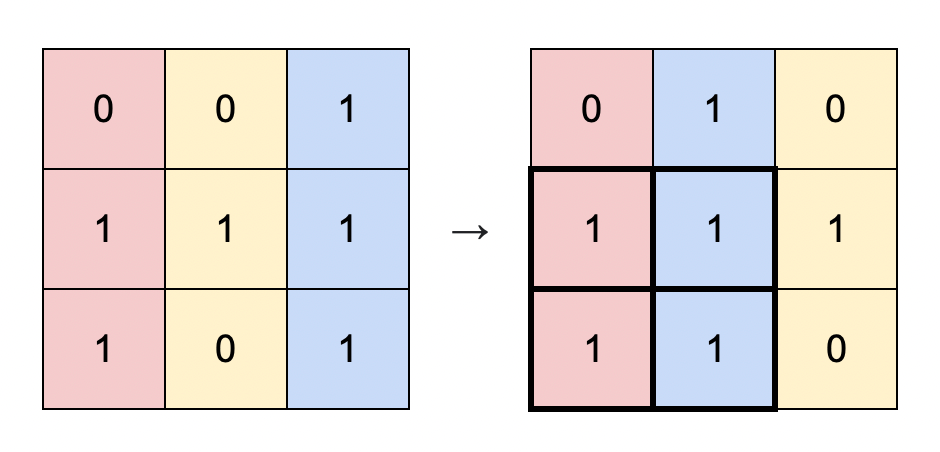You are given a binary matrix matrix of size m x n, and you are allowed to rearrange the columns of the matrix in any order.
Return the area of the largest submatrix within matrix where every element of the submatrix is 1 after reordering the columns optimally.
Example 1:
Input: matrix = [[0,0,1],[1,1,1],[1,0,1]] Output: 4 Explanation: You can rearrange the columns as shown above. The largest submatrix of 1s, in bold, has an area of 4.
Example 2:
Input: matrix = [[1,0,1,0,1]] Output: 3 Explanation: You can rearrange the columns as shown above. The largest submatrix of 1s, in bold, has an area of 3.
Example 3:
Input: matrix = [[1,1,0],[1,0,1]] Output: 2 Explanation: Notice that you must rearrange entire columns, and there is no way to make a submatrix of 1s larger than an area of 2.
Constraints:
m == matrix.lengthn == matrix[i].length1 <= m * n <= 105matrix[i][j]is either0or1.
class Solution:
def largestSubmatrix(self, matrix: List[List[int]]) -> int:
for i in range(1, len(matrix)):
for j in range(len(matrix[0])):
if matrix[i][j]:
matrix[i][j] = matrix[i - 1][j] + 1
ans = 0
for row in matrix:
row.sort(reverse=True)
for j, v in enumerate(row, 1):
ans = max(ans, j * v)
return ansclass Solution {
public int largestSubmatrix(int[][] matrix) {
int m = matrix.length, n = matrix[0].length;
for (int i = 1; i < m; ++i) {
for (int j = 0; j < n; ++j) {
if (matrix[i][j] == 1) {
matrix[i][j] = matrix[i - 1][j] + 1;
}
}
}
int ans = 0;
for (var row : matrix) {
Arrays.sort(row);
for (int j = n - 1, k = 1; j >= 0 && row[j] > 0; --j, ++k) {
int s = row[j] * k;
ans = Math.max(ans, s);
}
}
return ans;
}
}class Solution {
public:
int largestSubmatrix(vector<vector<int>>& matrix) {
int m = matrix.size(), n = matrix[0].size();
for (int i = 1; i < m; ++i) {
for (int j = 0; j < n; ++j) {
if (matrix[i][j]) {
matrix[i][j] = matrix[i - 1][j] + 1;
}
}
}
int ans = 0;
for (auto& row : matrix) {
sort(row.rbegin(), row.rend());
for (int j = 0; j < n; ++j) {
ans = max(ans, (j + 1) * row[j]);
}
}
return ans;
}
};func largestSubmatrix(matrix [][]int) int {
m, n := len(matrix), len(matrix[0])
for i := 1; i < m; i++ {
for j := 0; j < n; j++ {
if matrix[i][j] == 1 {
matrix[i][j] = matrix[i-1][j] + 1
}
}
}
ans := 0
for _, row := range matrix {
sort.Ints(row)
for j, k := n-1, 1; j >= 0 && row[j] > 0; j, k = j-1, k+1 {
ans = max(ans, row[j]*k)
}
}
return ans
}
func max(a, b int) int {
if a > b {
return a
}
return b
}

